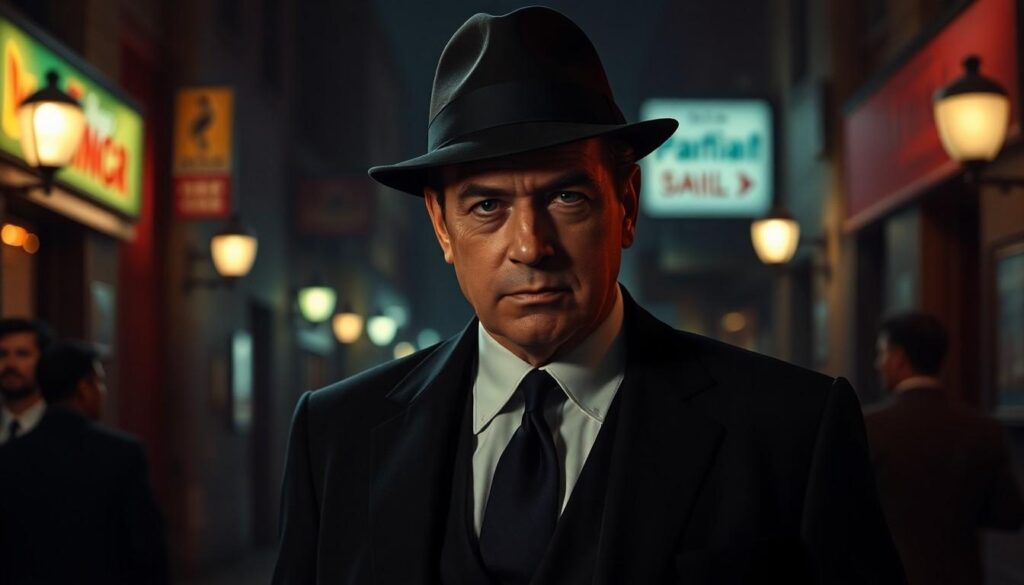When we think of the mafia, certain legendary names immediately come to mind. These aren’t just any names—they’re powerful identifiers that have shaped the underworld and popular culture for generations. From the streets of Sicily to the concrete jungles of New York and Chicago, these monikers carry weight, history, and often a chilling reputation.
We’ve compiled the ultimate list of top mafia names that have dominated organized crime throughout history. Whether you’re researching for a novel, curious about criminal history, or simply fascinated by mob culture, our comprehensive guide will take you through the most notorious and influential names in the mafia industry. These aren’t just people—they’re legends who built criminal empires and left indelible marks on society.
The Most Feared Italian Mafia Names Throughout History
The Italian Mafia has produced some of history’s most terrifying and powerful crime figures. These legendary bosses built criminal empires that extended far beyond Italy’s borders, creating legacies of fear that persist to this day. Many established family dynasties whose names became synonymous with organized crime, wielding influence that reached into politics, business, and entertainment. From Sicily to the American shores, these notorious names commanded respect through violence and strategic genius. Their reputations were built on brutal enforcement of their own codes of honor and justice.
Carlo Gambino
Carlo Gambino stands as one of the most successful crime bosses in American history, earning the nickname “The Boss of Bosses.” His rise to power began in the 1950s when he took control of what would become the Gambino crime family. Unlike his flashier contemporaries, Gambino operated with remarkable discretion, avoiding media attention and maintaining a low-profile lifestyle in a modest Brooklyn house. His empire expanded through strategic alliances and calculated eliminations of rivals, allowing him to control vast gambling, loan sharking, and protection rackets. FBI surveillance files described him as “one of the smoothest and best-connected mobsters in the country,” noting his ability to corrupt officials and evade prosecution throughout his 20-year reign.
Lucky Luciano
Lucky Luciano revolutionized organized crime in America by creating the modern structure still used by Mafia families today. Born Salvatore Lucania in Sicily, he earned his nickname “Lucky” after surviving a brutal throat-slashing attack in 1929. Luciano’s greatest contribution to organized crime was establishing “The Commission,” a governing body that mediated disputes between families and approved major decisions. His business approach to crime transformed disorganized street gangs into sophisticated criminal enterprises spanning illegal gambling, prostitution, and drug trafficking. Even though serving 10 years in prison and eventual deportation to Italy, Luciano’s organizational blueprint remained the foundation of American Mafia operations for decades after his 1962 death.
Totò Riina
Totò Riina earned his fearsome reputation as “The Beast” through unprecedented brutality as head of Sicily’s Corleonesi clan. His systematic campaign of violence against rival Mafia families and the Italian state claimed hundreds of lives during the 1980s and early 1990s. Riina personally ordered the assassinations of prominent anti-Mafia prosecutors Giovanni Falcone and Paolo Borsellino, shocking the nation and triggering a massive government crackdown. His ruthlessness extended to dissolving children in acid and bombing cultural landmarks to intimidate authorities. After 23 years as a fugitive, Riina was finally captured in 1993 and remained imprisoned until his death in 2017, never showing remorse for his estimated 150 murder orders.
Bernardo Provenzano
Bernardo Provenzano spent an astonishing 43 years as a fugitive, earning the nickname “The Phantom of Corleone” for his ability to evade capture. Taking control after Riina’s arrest, Provenzano adopted a less violent approach that allowed Cosa Nostra to rebuild its power through political corruption and legitimate business infiltration. His communications network relied on typed notes called “pizzini,” delivered by a trusted messenger system that prevented electronic surveillance. When authorities finally located Provenzano in 2006, they found him living in a spartan shepherd’s hut outside Corleone, using antibiotics rather than risking detection at hospitals. His capture ended one of the longest manhunts in Italian history and marked a important blow to Sicilian Mafia operations.
Michele Greco
Michele Greco, known as “The Pope,” controlled the Sicilian Mafia Commission during the bloody Mafia wars of the 1980s. His nickname stemmed from his role as mediator and his deceptively gentle demeanor that masked a ruthless nature. Greco’s family estate, “La Favarella,” served as the headquarters for Mafia summits where executions were planned under the guise of pastoral gatherings. His influence extended into local politics, where he maintained connections that protected his criminal enterprises for decades. When finally brought to trial in the famous Maxi Trial of 1986, Greco received 16 life sentences for ordering dozens of murders, including those of judges, politicians, and police officials who threatened Mafia interests.
The Rise of Cosa Nostra: Influential Sicilian Mafia Families

While the term “Cosa Nostra” originated with the Sicilian Mafia, it became synonymous with the Italian-American crime organizations that established deep roots in the United States. These powerful families transformed organized crime in America, creating structures inspired by their Sicilian ancestors but uniquely adapted to their new environment.
The Powerful Corleone Family Legacy
The Corleone family, though fictional, has become the most recognizable mafia name thanks to Mario Puzo’s novel “The Godfather” and the iconic film adaptations. This fictional dynasty closely mirrors the operations and influence of real mafia families, particularly the Genovese crime family. Founded by Charles “Lucky” Luciano and later headed by Vito Genovese, the Genovese family maintained iron control over various illicit enterprises throughout New York City. Their adaptability in embracing new technologies for illegal operations set them apart from other criminal organizations and cemented their position as one of the most powerful mafia dynasties in American history.
The Infamous Gambino Crime Dynasty
The Gambino family stands as one of the five dominant mafia families that shaped organized crime in New York City. Their rise to power began under Vincent Mangano’s leadership until his mysterious disappearance in 1951, allegedly orchestrated by Albert Anastasia. Following Anastasia’s assassination in 1957, Carlo Gambino seized control and rapidly expanded the family’s criminal empire through strategic alliances and meticulous planning.
After Gambino’s death in 1976, leadership passed to Paul Castellano, whose reign ended dramatically in 1985 when John Gotti orchestrated his assassination outside Sparks Steakhouse in Manhattan. Gotti, nicknamed the “Teflon Don” for initially evading conviction, ruled with unprecedented flamboyance until his underboss Sammy “The Bull” Gravano’s testimony finally sent him to prison.
The family’s criminal activities have continued into recent decades, facing important FBI crackdowns in 2008 and experiencing further turmoil with the 2019 assassination of acting boss Frank Cali. Even though these setbacks, the Gambino name remains synonymous with organized crime in America, representing one of the most enduring and influential criminal organizations in mafia history.
Famous American Mafia Bosses Who Ruled the Underworld

American mafia history features some of the most infamous crime figures who transformed organized crime into sophisticated criminal enterprises. These legendary bosses didn’t just dominate headlines—they rewrote the rules of the underworld.
Lucky Luciano: The Father of Organized Crime
Charles “Lucky” Luciano stands as the undisputed founder and architect of organized crime in America. Born in Sicily before immigrating to the United States, Luciano revolutionized the criminal underworld by establishing a more structured and business-oriented approach to illicit activities. His most important contribution came through creating “The Commission,” an ingenious power-sharing arrangement between New York City’s Five Families: Bonanno, Colombo, Gambino, Genovese, and Lucchese. This landmark system prevented bloody turf wars while consolidating authority within the American Mafia. Through his vision and leadership, Luciano transformed disorganized criminal gangs into a sophisticated network that operated with corporate-like efficiency, forever changing the industry of organized crime in America.
Al Capone: Chicago’s Most Notorious Kingpin
Al Capone began his criminal journey in New York City as a member of the Five Points Gang before relocating to Chicago where he co-founded the infamous Chicago Outfit. During Prohibition, Capone built an empire through bootlegging, smuggling, and various illegal enterprises that generated enormous profits. Known for his brutal tactics, Capone orchestrated the notorious Saint Valentine’s Day Massacre in which seven rival gang members were murdered—an act so shocking it earned him the designation “Public Enemy No. 1” by Chicago authorities. Even though his violent reputation, Capone maintained a complex operation of bribery involving law enforcement and government officials to protect his criminal activities. Authorities finally captured the elusive kingpin not for his violent crimes but for tax evasion. Following his prison sentence, Capone was eventually released and died in 1947, leaving behind a substantial fortune and an indelible mark on American criminal history.
Paul Castellano: The Business-Minded Don
Paul Castellano transformed the Gambino crime family by focusing on legitimate business fronts rather than traditional mob activities. Under his leadership, the family reached unprecedented financial heights through sophisticated operations in money laundering, construction, food industries, and extortion—deliberately avoiding the riskier drug trade. Castellano lived extravagantly in a 17-room Staten Island mansion modeled after the White House, showcasing his business success and ambition. His downfall came in 1985 when growing resentment over his demands for larger profit cuts and leadership style culminated in his assassination outside a Manhattan restaurant—a dramatic hit that shocked the criminal underworld and signaled changing power dynamics within the Mafia.
Meyer Lansky: The Mob’s Financial Genius
Meyer Lansky earned his reputation as “The Mob’s Accountant” through his exceptional financial acumen and business partnerships with Lucky Luciano. Specializing in gambling enterprises, Lansky pioneered the establishment of lucrative casinos in Las Vegas and Cuba, creating legitimate fronts for illicit money flows. His sophisticated financial strategies helped modernize organized crime’s approach to money management while maintaining a relatively low profile compared to other mob figures. Remarkably, even though decades in organized crime, Lansky was never convicted of serious offenses beyond illegal gambling charges. His criminal career ended naturally when he died of lung cancer in 1982, leaving behind a legacy as one of the most financially successful mafia figures in American history.
Arnold Rothstein: The Original Criminal Mastermind
Arnold “The Brain” Rothstein operated as New York’s premier mob kingpin during the early 20th century, earning his nickname through his exceptional strategic thinking. Widely believed to have fixed the 1919 Industry Series in one of sports’ most infamous scandals, Rothstein revolutionized organized crime by applying business principles to criminal enterprises. His innovative approach treated illegal activities as corporate ventures, establishing organizational structures and professional standards previously unseen in the criminal industry. Rothstein’s brilliant criminal career came to an abrupt end in 1928 when he was murdered, but his influence continued through the many future mob leaders he mentored and inspired during his reign at the top of New York’s underworld.
Russian Mafia Names That Dominated Post-Soviet Crime

The collapse of the Soviet Union created a power vacuum that allowed organized crime to flourish. Russian mafia groups quickly established themselves as formidable criminal enterprises, with several key figures rising to notorious prominence.
Vor v Zakone: The Code of the Thieves-in-Law
“Vor v Zakone” translates to “Thief-in-Law” and represents the elite class of Russian organized crime. These highly respected criminals adhere to a strict honor code that demands loyalty, honesty among thieves, and complete rejection of state authority. Their influence extends throughout the criminal underworld, where they serve as mediators and leaders within various criminal networks. The title isn’t easily earned—it requires years of criminal experience, prison time, and unwavering commitment to the thieves’ code. Notable Vors include Zakhary Kalashov (born 1953), who became one of the most influential figures in the Russian mafia, and Vyacheslav Ivankov (1940-2009), whose connections extended to Russian state intelligence organizations. The authority of Vors transcends geographical boundaries, allowing them to command respect in criminal circles across multiple countries and resolve disputes among different criminal factions.
The Solntsevskaya Brotherhood’s Reign
The Solntsevskaya Bratva emerged as perhaps the most powerful crime syndicate in post-Soviet Russia, operating from its base in the Moscow suburb of Solntsevo. With approximately 5,000 members, this organization built an empire through drug trafficking, prostitution, gun smuggling, and widespread racketeering operations. Sergei Mikhailov, born in 1958, rose as a key leader of this formidable criminal network, establishing himself as both a businessman and criminal mastermind. The brotherhood capitalized on economic instability following the Soviet collapse, strategically investing in various sectors of the Russian economy through funds acquired during the privatization of state enterprises. Their influence became so substantial that they controlled important portions of Russia’s financial system and legitimate businesses. The group demonstrated their ruthless approach to business disputes in 1996 when they allegedly orchestrated the murder of American businessman Paul Tatum after he refused to sell his share in the Radisson-Slavyanskaya Hotel to their associates. Their power was further enhanced by recruiting former military and KGB personnel, providing them with specialized skills and connections that solidified their dominance in the criminal industry.
Asian Triad Leaders Who Built Criminal Empires

Asian organized crime syndicates have created some of the most sophisticated criminal networks in the industry, with leadership structures that blend ancient traditions with modern criminal enterprises. From Hong Kong’s secretive Triad societies to Japan’s structured Yakuza groups, these organizations have been led by figures whose influence extended across continents.
The Dragon Heads of Hong Kong
At the apex of the Triad hierarchy sit the legendary “Dragon Heads” or “Mountain Masters,” who command absolute loyalty within their criminal empires. Cheung Yat-tong stands out as one of the most influential Dragon Heads in history, having expanded the Wo Hop To triad society into a formidable criminal organization. The notorious Wan Kuok-koi, commonly known as “Broken Tooth Koi,” dominated the Macau underworld as a leader of the powerful 14K Triad until his eventual arrest. These Dragon Heads oversee vast criminal networks involved in drug trafficking, extortion, gambling, and human smuggling while maintaining strict codes of silence. Their operations remain highly secretive, with current leadership details rarely disclosed publicly, allowing them to operate in the shadows while extending their influence throughout legitimate businesses across Asia.
Yakuza Oyabun: Japan’s Crime Lords
Japan’s Yakuza organizations function under the leadership of Oyabun, crime bosses whose title literally translates to “father” in recognition of their paternal role within the criminal family structure. Kazuo Taoka earned his reputation as the “Godfather of the Yamaguchi-gumi” by transforming this syndicate into Japan’s largest and most powerful criminal organization during the post-war period. Tsukasa Shirai continued this legacy of expansion, modernizing the Yamaguchi-gumi’s operations to adapt to changing economic conditions in Japan. The current Yamaguchi-gumi Oyabun, Shinobu Tsukasa, maintains the organization’s prominence even though increased law enforcement pressure and internal power struggles. Unlike their Triad counterparts, Yakuza leaders have historically maintained a semi-public presence in Japanese society, though recent anti-gang legislation has forced them to operate more discreetly. Yakuza Oyabun command complex hierarchical structures that blend traditional Japanese values with ruthless business acumen, allowing them to penetrate both illicit markets and legitimate industries throughout Japan.
Modern Mafia Figures Who Continue the Tradition

While legendary mafia bosses have shaped organized crime history, today’s figures continue their legacy with modern tactics and global reach.
The ‘Ndrangheta: Calabria’s Global Criminal Network
The ‘Ndrangheta has emerged as one of the most powerful and globally connected criminal organizations in the industry. Operating far beyond its Calabrian roots, this criminal network has established important presence across Europe, South America, and Australia. Their criminal portfolio includes extensive drug trafficking operations, systematic extortion schemes, and sophisticated money laundering networks. Notable figures like Matteo Messina Denaro, known as “Diabolik,” have managed to evade authorities for decades, with Denaro remaining a fugitive since 1993 even though being implicated in dozens of murders.
Giuseppe “U Capra” Giorgi represents another testament to the organization’s ability to protect its leadership, having successfully hidden for 23 years before his capture in 2017. His criminal enterprises spanned drug trafficking, illegal firearms sales, and even hazardous waste disposal. The organization’s complex hierarchy became more visible after the capture of Giuseppe Pelle in 2018, a member of the ‘Ndrangheta’s ruling council who was found in an isolated house in Calabria. These leadership figures demonstrate the organization’s remarkable resilience and ability to maintain secrecy even though intense law enforcement pressure.
The New Generation of Digital Mafia Operators
Traditional crime families have adapted their operations to embrace modern technology and digital infrastructure. Criminal organizations now leverage sophisticated communication systems, encryption technologies, and digital financial networks to expand their illicit operations. The Gambino crime family, now under Street Boss Lorenzo Manino, has maintained influence while adopting a lower profile than previous generations. Manino served as the family’s underboss from 2014 to 2018 before assuming his current leadership position in March 2019.
Michael “Big Mike” DeSantis represents this evolution as the current acting boss of the Lucchese crime family. Since his induction in November 1989, DeSantis has navigated the organization through changing times, including involvement in important power struggles like the failed attempt to eliminate Alfonso D’Arco. Drug cartels have similarly embraced technological advancement, with organizations like the Jalisco New Generation Cartel utilizing digital tools to strengthen their control over trafficking routes. Their operations now feature advanced communications security, cryptocurrency transactions, and digital monitoring systems that would have been unimaginable to previous generations of crime figures. These modern organizations demonstrate how traditional criminal enterprises have evolved rather than disappeared, adapting to new opportunities in our increasingly connected industry.
How Mafia Nicknames Became Part of Pop Culture

Origin of Nicknames
Mafia nicknames originated from distinctive personal traits, physical characteristics, or important life events of each mobster. Al Capone received his famous “Scarface” moniker after a 1917 bar fight where his face was slashed with a broken bottle. The vegetable market became an unlikely source for Ciro Terranova’s nickname “Artichoke King,” which he earned through his ruthless control of the artichoke trade using extortion tactics. Joseph Bonanno’s “Joe Bananas” nickname likely stemmed from a play on his surname and possibly his unpredictable temperament or behavior.
Media and Public Perception
Press coverage played a crucial role in cementing these colorful monikers in the public consciousness. Newspapers during the Prohibition era eagerly reported on organized crime activities, using these vivid nicknames to capture readers’ attention and sell more papers. The media’s fascination with figures like Al Capone transformed “Scarface” into a household name throughout the 1920s. These nicknames became shorthand references that helped the public recognize and remember notorious crime figures during a time of heightened awareness about organized crime.
Cultural Impact
Mafia nicknames have transcended their criminal origins to become fixtures in entertainment and popular culture. Films like “The Godfather” and “Scarface” incorporated authentic mob nicknames, further embedding them in our cultural lexicon. TV shows depicting organized crime regularly feature characters with colorful monikers that mirror real-life counterparts. These nicknames have contributed significantly to the romanticization of mafia figures, even though the fact that many mobsters actually disliked their public nicknames and discouraged their use among associates.
Unique Identifiers
Within mafia culture, nicknames function as distinct identifiers that set individuals apart within their criminal organizations. The uniqueness of these monikers carries such importance that in some mafia circles, strict rules dictate that nicknames must be original and cannot be changed once assigned. “Cadillac Frank” Salemme earned his nickname through his flashy lifestyle and preference for luxury vehicles. Vincent “Mad Dog” Coll’s moniker reflected his violent and unpredictable nature as a notorious hitman. Willie Alderman’s chilling nickname “Ice Pick Willie” described his preferred murder method, while Philip “The Chicken Man” Testa’s connection to the poultry business provided the basis for his identifier.
The Impact of Top Mafia Names on Film and Television

Iconic Mafia Characters
- Tony Soprano has revolutionized television’s portrayal of gangsters through James Gandolfini’s nuanced performance. His character on HBO’s “The Sopranos” masterfully balances brutal criminality with profound vulnerability, creating one of the most complex mobsters ever depicted on screen. Gandolfini’s portrayal set a new standard for multi-dimensional gangster characters, influencing countless crime dramas that followed.
- Frank Lucas became a household name after Denzel Washington portrayed him in “American Gangster,” a film that earned two Academy Award nominations. His real-life story as a Harlem drug kingpin who built a trafficking empire showcases the intelligence and charisma that defined successful crime bosses. Washington’s performance captures Lucas’s strategic brilliance while highlighting the inevitable consequences of his criminal lifestyle.
Notable Mafia Families
- The Bufalino Family gained renewed attention through Martin Scorsese’s epic “The Irishman,” which explores their important historical influence. Robert De Niro and Joe Pesci deliver mesmerizing performances that illuminate the relationship between Frank Sheeran and Russell Bufalino, particularly their alleged connection to Jimmy Hoffa’s disappearance. Their portrayal demonstrates how mafia families operated at the intersection of organized crime and American politics.
- The Winter Hill Gang reached iconic status in “Black Mass,” with Johnny Depp portraying the notorious Whitey Bulger. Their story reveals the complex web of relationships between organized crime, law enforcement, and politics in Boston, where Bulger’s brother served as the city’s mayor. This criminal organization’s portrayal shows how deeply entrenched mafia influence became in American civic life.
- The Corleone Family stands as the definitive fictional mafia dynasty, though not explicitly mentioned in our source material. Their saga in “The Godfather” trilogy has become the template against which all mafia portrayals are measured, influencing countless films and television shows over decades.
Cultural and Cinematic Impact
Films like “Scarface” and “The Godfather” have transcended their status as crime dramas to become cultural phenomena that influence music, fashion, and language. “Scarface” specifically inspired the aesthetic and themes of “Miami Vice” and provided the atmospheric blueprint for video games like “Grand Theft Auto: Vice City.”
The pursuit of realism and historical accuracy in films such as “American Gangster” and “The Irishman” has elevated mafia portrayals beyond simple entertainment. Directors increasingly draw from actual events and figures, creating narratives that serve as both compelling drama and historical documentation.
Performances by acting legends such as Denzel Washington, Robert De Niro, and James Gandolfini have defined the genre through their authentic and multifaceted portrayals. Their work has transformed how audiences perceive organized crime figures, highlighting both the brutality and humanity of these complex characters.
Conclusion: The Enduring Legacy of Notorious Mafia Names
From Sicily to Chicago and beyond the legendary figures we’ve explored have left an indelible mark on criminal history and popular culture. Their names continue to fascinate us not merely as criminals but as complex characters who built empires through ruthlessness intelligence and adaptation.
As organized crime evolves in our digital age these notorious figures remind us of the mafia’s remarkable ability to transform with the times. Whether immortalized in film franchises like “The Godfather” or documented in news headlines their legacies endure.
The colorful nicknames elaborate codes of honor and sophisticated operations of these crime bosses will continue to captivate our imagination even as their real-industry counterparts face increasing challenges from law enforcement worldwide.
Frequently Asked Questions
Who was the most influential mafia boss in American history?
Lucky Luciano is widely considered the most influential mafia boss in American history. He revolutionized organized crime by establishing “The Commission,” a governing body that mediated disputes between crime families. This innovation transformed disorganized criminal groups into a structured nationwide syndicate with clear rules and territories, creating the modern American mafia as we know it today.
What made the Corleone family so famous?
The Corleone family gained fame through Mario Puzo’s novel “The Godfather” and the subsequent film trilogy directed by Francis Ford Coppola. While fictional, the Corleones were inspired by real mafia families like the Genovese and Bonanno crime organizations. Their portrayal captured the essence of mafia operations, family dynamics, and the code of honor that governed these criminal enterprises, cementing them as the definitive fictional mafia dynasty.
How did Al Capone get his nickname “Scarface”?
Al Capone received the nickname “Scarface” after being slashed across his left cheek during a bar fight in his youth. The incident occurred when Capone made inappropriate remarks about a woman at a Brooklyn nightclub, prompting her brother to attack him with a knife. Though Capone detested the nickname, it became his most recognizable moniker throughout his notorious criminal career in Chicago.
What is the ‘Ndrangheta and why is it significant today?
The ‘Ndrangheta is a powerful organized crime syndicate originating from Calabria, Italy, that has grown into one of the world’s most formidable criminal organizations. Unlike other mafia groups, it’s built on blood relationships, making it nearly impenetrable to law enforcement. Its significance today stems from its global reach in drug trafficking, money laundering, and infiltration of legitimate businesses across Europe, the Americas, and Australia.
How did the Russian mafia emerge as a global power?
The Russian mafia emerged as a global power following the collapse of the Soviet Union in 1991. The resulting economic chaos and power vacuum created perfect conditions for organized crime to flourish. Criminal groups like the Solntsevskaya Brotherhood seized control of newly privatized industries and established international connections. Their combination of sophisticated financial operations, political influence, and brutal enforcement tactics quickly established them as major players in global organized crime.
What role did women play in traditional mafia organizations?
In traditional mafia organizations, women officially held no formal power but wielded significant influence behind the scenes. They maintained family networks, passed down cultural traditions, and often managed finances. While the “omertà” code prevented them from direct involvement in criminal activities, some notable women like Judy Moran and Virginia Hill broke these norms. Modern crime organizations have gradually seen women take more active roles in operations and leadership.
How do modern mafia organizations differ from their historical counterparts?
Modern mafia organizations have adapted to technological advances and globalization while maintaining their core structures. Today’s crime syndicates utilize encrypted communications, cryptocurrency, and digital money laundering techniques. They’ve diversified beyond traditional rackets into cybercrime, identity theft, and online fraud. While they maintain territorial control and hierarchical leadership, they operate with greater international coordination and employ more sophisticated financial methods than their predecessors.
What impact did “The Sopranos” have on public perception of the mafia?
“The Sopranos” revolutionized public perception of the mafia by presenting a complex, humanized portrayal of organized crime figures. Through Tony Soprano’s character, viewers witnessed the psychological struggles, family dynamics, and ethical conflicts of a modern mobster. The show demythologized gangster glamour while exploring themes of mental health, generational change, and the decline of traditional mafia power, creating a more nuanced understanding of organized crime in American culture.
How did mafia nicknames originate and what purpose did they serve?
Mafia nicknames originated from distinctive physical traits, personality characteristics, or significant life events of mobsters. They served multiple practical purposes: creating memorable identities, concealing real names during illegal activities, and building fearsome reputations. Within mafia culture, these nicknames followed strict rules—they had to be unique and couldn’t be changed. Media coverage during Prohibition popularized these colorful monikers, embedding them in public consciousness and contributing to mafia mythology.
What factors led to the decline of traditional mafia power in America?
The decline of traditional mafia power in America resulted from several converging factors. The RICO Act (Racketeer Influenced and Corrupt Organizations) gave prosecutors powerful tools to target entire criminal enterprises. FBI surveillance techniques improved dramatically, while the witness protection program encouraged informants to testify. Cultural shifts weakened omertà (code of silence), and changing demographics and economics reduced traditional recruitment pools. Meanwhile, newer criminal organizations emerged to compete for territory and profits.







